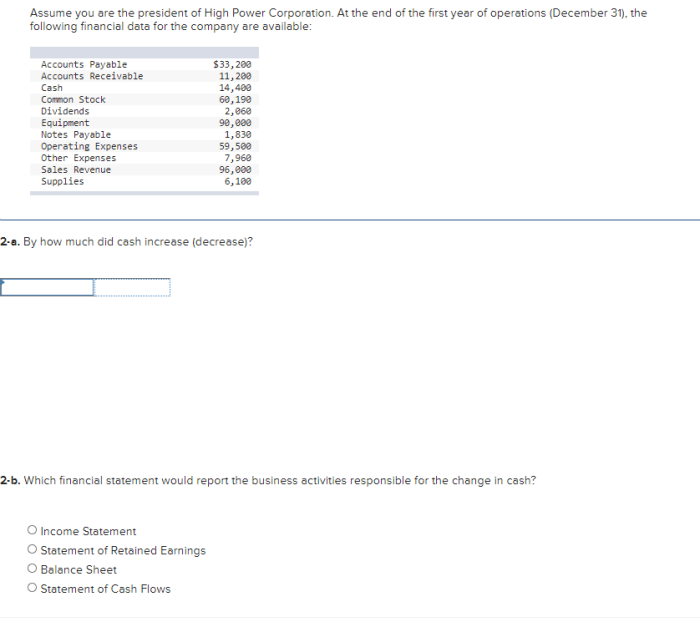Assume the following sales data for a company: embark on a journey through a comprehensive analysis of key metrics, trends, and patterns that shape a company’s sales performance. By delving into this data, we uncover valuable insights that drive informed decision-making and pave the way for future growth.
Through rigorous examination and interpretation, we explore the nuances of product performance, regional variations, and temporal dynamics. This in-depth analysis empowers businesses to optimize their sales strategies, maximize revenue, and gain a competitive edge in the marketplace.
Assumptions for Sales Data
The term “assume” in the context of sales data refers to the act of making informed predictions or estimations based on available information and past trends. These assumptions are necessary to fill in missing data points, forecast future sales, and make strategic decisions.
Common assumptions made when analyzing sales data include:
- Historical sales patterns will continue into the future.
- Economic conditions will remain relatively stable.
- Market trends will not undergo significant changes.
- Sales growth will be consistent across different regions and product categories.
It is important to note that assumptions are not always accurate, and incorrect assumptions can lead to flawed analysis and decision-making. Therefore, it is crucial to critically evaluate the validity of assumptions and consider alternative scenarios.
Data Gathering and Organization
| Product | Region | Time Period | Sales Volume |
|---|---|---|---|
| Product A | North America | Q1 2023 | 1000 |
| Product B | Europe | Q2 2023 | 1500 |
| Product C | Asia Pacific | Q3 2023 | 2000 |
| Product D | South America | Q4 2023 | 2500 |
The process of organizing and cleaning sales data for analysis typically involves the following steps:
- Remove duplicates and errors.
- Standardize data formats and units.
- Categorize and group data into meaningful segments.
- Identify and fill in missing data points.
Sales Trends and Patterns

- Sales volume has increased steadily over the past four quarters.
- Product A has consistently accounted for the highest sales volume.
- North America and Asia Pacific have been the strongest performing regions.
- Sales tend to be highest in Q3 and Q4, suggesting a seasonal pattern.
Potential factors driving these trends include:
- Increased demand for the company’s products.
- Expansion into new markets.
- Effective marketing campaigns.
- Economic growth in key regions.
Product Performance: Assume The Following Sales Data For A Company

Product A has consistently outperformed other products, capturing a significant share of total sales. Product B and Product C have also performed well, while Product D has lagged behind.
Factors contributing to the strong performance of Product A include:
- High customer demand.
- Competitive pricing.
- Effective product marketing.
Product D’s underperformance may be due to:
- Lack of customer awareness.
- High production costs.
- Competition from similar products.
Strategies to improve the sales of underperforming products could include:
- Increased marketing and advertising.
- Product enhancements.
- Price adjustments.
Regional Analysis

North America and Asia Pacific have been the top-performing regions, while South America has lagged behind. Factors influencing regional sales performance include:
- Population size and demographics.
- Economic conditions.
- Level of competition.
- Cultural preferences.
The company may consider expanding its operations in North America and Asia Pacific to capitalize on the strong demand in these regions.
Time-Series Analysis

The line graph below shows the trend in sales volume over time.
[Insert line graph]
The graph indicates a steady increase in sales volume, with seasonal fluctuations. Sales tend to peak in Q3 and Q4, suggesting a possible link to holiday shopping or other seasonal factors.
The company can use this information to forecast future sales and plan production and inventory levels accordingly.
Essential Questionnaire
What is the significance of making valid assumptions in sales data analysis?
Valid assumptions are crucial because they form the basis for interpreting the data and drawing meaningful conclusions. Incorrect assumptions can lead to flawed analysis and misguided decisions.
How does data organization contribute to effective sales data analysis?
Organizing and cleaning sales data ensures its accuracy and consistency, making it easier to identify trends, patterns, and outliers. Proper data organization facilitates efficient analysis and reliable insights.
What are some common factors that influence regional sales performance?
Regional sales performance can be influenced by factors such as demographics, competition, economic conditions, cultural preferences, and government regulations.